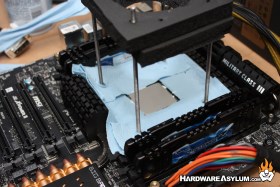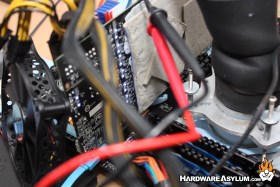How I prepared for the MOA 2012 Americas Qualifier
Author: Dennis Garcia
Published: Sunday, May 20, 2012
Preparation
Any time you attempt to do any extreme overclocking you must first prepare your hardware. For processors and motherboards this means good insulation against condensation. Personally I am a kneaded eraser kind of guy, not only is it easy to apply but it comes off clean and with virtually no effort.
There are several ways to insulate a motherboard. Some overclockers prefer to use Vaseline while others cut out layers of neoprene. Regardless of method the ideas are the same. You want to protect the electronics from condensation and by sealing up the areas that will be below zero you will protect them from the moisture that is in the air.
On the X79 Big Bang you will find a large square opening around the processor flanked by memory slots, PWM located at the top and a heatsink located at the bottom. Ironically enough there is a CBB jumper near the CPU socket that becomes inaccessible after you have insulated. I never used this jumper for the competition so who knows what it actually does.
After the eraser I put down a layer of blue paper shop towels to soak up any water that may form around the phase head or LN2 container.
There are several ways to insulate a motherboard. Some overclockers prefer to use Vaseline while others cut out layers of neoprene. Regardless of method the ideas are the same. You want to protect the electronics from condensation and by sealing up the areas that will be below zero you will protect them from the moisture that is in the air.
On the X79 Big Bang you will find a large square opening around the processor flanked by memory slots, PWM located at the top and a heatsink located at the bottom. Ironically enough there is a CBB jumper near the CPU socket that becomes inaccessible after you have insulated. I never used this jumper for the competition so who knows what it actually does.
After the eraser I put down a layer of blue paper shop towels to soak up any water that may form around the phase head or LN2 container.
Video card prep is a little more involved and I took two different approaches. The first was to cover a good portion of the card in kneaded eraser and use that as a condensation block. Sadly what I discovered was that even with the eraser the card got quite frosty and would eventually drip on the motherboard. To solve this I put a piece of sticky back FrostKing insulation on the back of the card. This prevented the frost and gave me something to protect the card when it wasn't installed.
My second approach was to use LET (Liquid Electrical Tape) and basically paint the card in waterproof plastic. This worked great but offered no insulation to the card so I still needed to use some FrostKing insulation to prevent frost from forming.
What I discovered is that with the HD7970 I got better memory overclocking performance using kneaded eraser than I did with the LET. My suspicion is that the eraser helped to keep all of the memory chips at a constant temperature whereas the LET didn't. Sadly using eraser on the back of the card allowed water to get in the PCIE slot and created problems.
Going forward I'll likely use a combo of eraser on the front and LET on the back. Seemed like a good compromise.
My second approach was to use LET (Liquid Electrical Tape) and basically paint the card in waterproof plastic. This worked great but offered no insulation to the card so I still needed to use some FrostKing insulation to prevent frost from forming.
What I discovered is that with the HD7970 I got better memory overclocking performance using kneaded eraser than I did with the LET. My suspicion is that the eraser helped to keep all of the memory chips at a constant temperature whereas the LET didn't. Sadly using eraser on the back of the card allowed water to get in the PCIE slot and created problems.
Going forward I'll likely use a combo of eraser on the front and LET on the back. Seemed like a good compromise.



